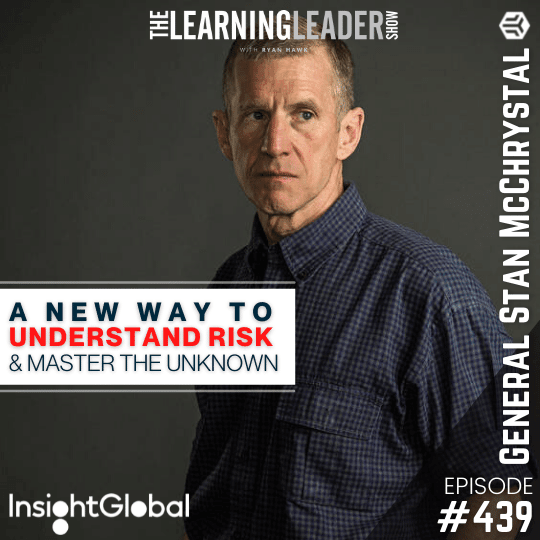General Stanley McChrystal retired in July 2010 as a four-star general in the U.S. Army. His last assignment was as the commander of the International Security Assistance Force and as the commander of the U.S. forces in Afghanistan. He had previously served as the director of the Joint Staff and as the commander of the Joint Special Operations Command. The author of My Share of the Task, Team of Teams, and Leaders, he is currently a senior fellow at Yale University’s Jackson Institute for Global Affairs and the co-founder of the McChrystal Group, a leadership consulting firm.
WATCH this conversation on YouTube. And SUBSCRIBE!
FORBES recently called WELCOME TO MANAGEMENT, “the best leadership book of 2020.”
Be part of “Mindful Monday” — Text LEARNERS to 44222
Subscribe on iTunes or Stitcher Radio
The Learning Leader Show
- Stan’s mentor for his military career and still to this day: an Army officer with a thick southern accent, Major John Vines. His advice: “If there are 3 people responsible for feeding the dog, the dog is going to starve.”
- Stan graduated from West Point 31 years after his father did. Major General George Smith Patton (General George Patton’s son) handed him his diploma. Stan wondered at that moment, what kind of leader you wanted to be. And he came up with, “a good one.” Now the more fundamental question is “What do good leaders do?” Instead of just being a good leader, Stan desires to be an effective leader.
- Effective leaders:
- Tactically competent
- Are morally good
- Respected
- They create an environment where others want to follow
- They shape how people think and behave
- People that others want to follow
- Have high standards
- Risk: in reality, risk is neither mathematical nor finite. Its impact depends to a great extent on how we perceive, process, and respond.
- A healthy risk immune system successfully executes 4 imperatives: Detect, Assess, Respond, and Learn
- “Risk comes at you from out of the blue, from every angle, when least convenient. There is a cost in becoming overly focused on risk and another at ignoring them. And the sweet spot between the two extremes moves with the circumstances around you.”
- “I chose a soldier’s life for many reasons, one of which was the desire to perceive myself as a courageous risk-taker. I liked the idea of taking risks that others would not.”
- Threat x Vulnerability = Risk
- Risk is an eternal challenge. But trying to anticipate or predict every possible risk is a fool’s errand. The key is to understand how we need to think about risk, and to then respond appropriately. Rather than living in dread of things we often can’t anticipate, duck, or dodge – we must remember these five key insights.
- Look Inward: The greatest risk to us is us.
- It’s Up to Us: We have a risk immune system
- Be holistic: It’s the system. Make it work
- Balance: The muscles you exercise will be strong: those you ignore will be vulnerabilities
- Risk is always with us, and it’s our responsibility to make our teams ready for it
- When taking command of the 2nd Ranger Battalion, Stan, along with the leaders of the unit, established The foundational skills – They called them the big 4:
- Physical conditioning
- Marksmanship
- Medical Skills
- Small Unit Drills
- But even before mastering basic skills, grounding both individuals and organizations with answers to the most basic questions that relate to the narrative is essential:
- What are our values?
- What exactly do we do? And why do we do it?
- What is expected of each of us?
- What went wrong with our response to COVID-19?
- 50 states operated separately instead of a united response
- “We weren’t unified”
- “Our leaders did not communicate effectively.”
- “You have to act before the population sees the requirement for it.”
- 50 states operated separately instead of a united response
- Have a front-line obsession – Stan was known for going on the front lines with his soldiers. As leaders, we should do the same with our teams. Be on the front lines to:
- See how it’s done with your own eyes, not just reports
- They need to see you go. They’ll appreciate it
- It helps create your self-identity
- The new hybrid model of in-office and at-home working…
- Be intentional
- Use technology
- Understand what you’re not doing
- Don’t get lazy
- How to deal with imposter syndrome?
- Ask, “What do I know?” “What’s my responsibility?” “You have to fight that crisis of confidence.”
- Excellence =
- Be less flexible on your basic values
- Be flexible with how a problem gets solved
- Apply to be part of my Leadership Circle
Resources:
- Read: WELCOME TO MANAGEMENT
- Be part of “Mindful Monday” — Text LEARNERS to 44222
- Read: RISK
- Connect with me on LinkedIn
- Join our Facebook Group: The Learning Leader Community
- To Follow Me on Twitter: @RyanHawk12
More Learning:
Episode 078: Kat Cole – From Hooters Waitress To President of Cinnabon
Episode 216: Jim Collins — How To Go From Good To Great
Episode #300: AJ & Keith Hawk – How To Instill Work Ethic & Curiosity In Your Children
Episode #303: General Stanley McChrystal – The New Definition Of Leadership


Leave A Comment